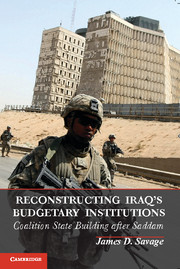Book contents
- Frontmatter
- Dedication
- Contents
- List of Tables
- List of Figures and Illustrations
- Preface
- Abbreviations
- 1 State Building and the Reconstruction of Iraq’s Budgetary Institutions
- 2 The Evolution of Iraqi Budgetary Institutions from the Ottomans and the British Mandate through Saddam
- 3 Prewar Planning for Iraq’s Economic and Budgetary Reconstruction
- 4 Boots on the Ground
- 5 Building Iraqi Ministerial Capacity
- 6 The 17th Benchmark and the Challenge of Iraqi Budget Execution
- 7 Building Iraqi Budgetary Capacity
- 8 Iraqi Budgeting
- 9 Successful State Building in Iraq?
- Bibliography
- Index
- References
3 - Prewar Planning for Iraq’s Economic and Budgetary Reconstruction
Published online by Cambridge University Press: 05 June 2014
- Frontmatter
- Dedication
- Contents
- List of Tables
- List of Figures and Illustrations
- Preface
- Abbreviations
- 1 State Building and the Reconstruction of Iraq’s Budgetary Institutions
- 2 The Evolution of Iraqi Budgetary Institutions from the Ottomans and the British Mandate through Saddam
- 3 Prewar Planning for Iraq’s Economic and Budgetary Reconstruction
- 4 Boots on the Ground
- 5 Building Iraqi Ministerial Capacity
- 6 The 17th Benchmark and the Challenge of Iraqi Budget Execution
- 7 Building Iraqi Budgetary Capacity
- 8 Iraqi Budgeting
- 9 Successful State Building in Iraq?
- Bibliography
- Index
- References
Summary
There is a general consensus that prewar planning for postconflict stabilization and reconstruction operations in Iraq proved to be woefully inadequate. This assessment may be summarized this way: The United States went into the business of state building in Iraq reluctantly and ill-prepared. As a presidential candidate, George W. Bush claimed the Clinton administration overextended and misdirected American foreign affairs. Bush declared that as president he would avoid Clinton’s overseas interventions and “would be very careful about using our troops as nation builders. I believe the role of the military is to fight and win war and, therefore, prevent war from happening in the first place. . . . I believe we’re overextended in too many places.” This position coincided with Bush’s neoliberal domestic agenda, an aversion within the U.S. military for nation-building operations, and the prevailing “Washington Consensus” on international development assistance that favored a limited state and the promotion of market-based economies. The term “Washington Consensus,” coined in 1989, referred to ten economic policy reforms that included deregulation, privatization, trade liberalization, and, first and second on the list of reforms, fiscal discipline and pro-growth budgetary policies. The planning for the postconflict Iraq reflected this thinking. In preparation for the invasion of Iraq the Americans expected to decapitate Saddam’s political leadership and capture weapons of mass destruction (WMD) but provide only short-term humanitarian relief. Failing to find WMDs, the Bush administration’s purpose for liberating and occupying Iraqi became the establishment of a democratic political system acceptable to American ideological preferences and regional interests. The lead role for planning the invasion and coordinating the activities of civilian agencies rested with the Defense Department. The Defense Department’s leadership generally ignored the postconflict planning that did take place within the agencies, most famously the State Department’s “Future of Iraq Project.” The Defense Department neglected to prepare for “Phase IV” postconflict reconstruction, and instead focused on short-term humanitarian assistance. The occupation of Iraq would be relatively brief, with the government quickly turned over to sympathetic Iraqi expatriates. The American-led Coalition, often staffed by young, inexperienced neoconservatives, failed to anticipate the postinvasion security challenge and was completely unprepared for the immense reconstruction and state-building efforts that awaited it.
- Type
- Chapter
- Information
- Reconstructing Iraq's Budgetary InstitutionsCoalition State Building after Saddam, pp. 47 - 69Publisher: Cambridge University PressPrint publication year: 2013



